6.5.2: Mining
- Page ID
- 69393
\( \newcommand{\vecs}[1]{\overset { \scriptstyle \rightharpoonup} {\mathbf{#1}} } \)
\( \newcommand{\vecd}[1]{\overset{-\!-\!\rightharpoonup}{\vphantom{a}\smash {#1}}} \)
\( \newcommand{\dsum}{\displaystyle\sum\limits} \)
\( \newcommand{\dint}{\displaystyle\int\limits} \)
\( \newcommand{\dlim}{\displaystyle\lim\limits} \)
\( \newcommand{\id}{\mathrm{id}}\) \( \newcommand{\Span}{\mathrm{span}}\)
( \newcommand{\kernel}{\mathrm{null}\,}\) \( \newcommand{\range}{\mathrm{range}\,}\)
\( \newcommand{\RealPart}{\mathrm{Re}}\) \( \newcommand{\ImaginaryPart}{\mathrm{Im}}\)
\( \newcommand{\Argument}{\mathrm{Arg}}\) \( \newcommand{\norm}[1]{\| #1 \|}\)
\( \newcommand{\inner}[2]{\langle #1, #2 \rangle}\)
\( \newcommand{\Span}{\mathrm{span}}\)
\( \newcommand{\id}{\mathrm{id}}\)
\( \newcommand{\Span}{\mathrm{span}}\)
\( \newcommand{\kernel}{\mathrm{null}\,}\)
\( \newcommand{\range}{\mathrm{range}\,}\)
\( \newcommand{\RealPart}{\mathrm{Re}}\)
\( \newcommand{\ImaginaryPart}{\mathrm{Im}}\)
\( \newcommand{\Argument}{\mathrm{Arg}}\)
\( \newcommand{\norm}[1]{\| #1 \|}\)
\( \newcommand{\inner}[2]{\langle #1, #2 \rangle}\)
\( \newcommand{\Span}{\mathrm{span}}\) \( \newcommand{\AA}{\unicode[.8,0]{x212B}}\)
\( \newcommand{\vectorA}[1]{\vec{#1}} % arrow\)
\( \newcommand{\vectorAt}[1]{\vec{\text{#1}}} % arrow\)
\( \newcommand{\vectorB}[1]{\overset { \scriptstyle \rightharpoonup} {\mathbf{#1}} } \)
\( \newcommand{\vectorC}[1]{\textbf{#1}} \)
\( \newcommand{\vectorD}[1]{\overrightarrow{#1}} \)
\( \newcommand{\vectorDt}[1]{\overrightarrow{\text{#1}}} \)
\( \newcommand{\vectE}[1]{\overset{-\!-\!\rightharpoonup}{\vphantom{a}\smash{\mathbf {#1}}}} \)
\( \newcommand{\vecs}[1]{\overset { \scriptstyle \rightharpoonup} {\mathbf{#1}} } \)
\(\newcommand{\longvect}{\overrightarrow}\)
\( \newcommand{\vecd}[1]{\overset{-\!-\!\rightharpoonup}{\vphantom{a}\smash {#1}}} \)
\(\newcommand{\avec}{\mathbf a}\) \(\newcommand{\bvec}{\mathbf b}\) \(\newcommand{\cvec}{\mathbf c}\) \(\newcommand{\dvec}{\mathbf d}\) \(\newcommand{\dtil}{\widetilde{\mathbf d}}\) \(\newcommand{\evec}{\mathbf e}\) \(\newcommand{\fvec}{\mathbf f}\) \(\newcommand{\nvec}{\mathbf n}\) \(\newcommand{\pvec}{\mathbf p}\) \(\newcommand{\qvec}{\mathbf q}\) \(\newcommand{\svec}{\mathbf s}\) \(\newcommand{\tvec}{\mathbf t}\) \(\newcommand{\uvec}{\mathbf u}\) \(\newcommand{\vvec}{\mathbf v}\) \(\newcommand{\wvec}{\mathbf w}\) \(\newcommand{\xvec}{\mathbf x}\) \(\newcommand{\yvec}{\mathbf y}\) \(\newcommand{\zvec}{\mathbf z}\) \(\newcommand{\rvec}{\mathbf r}\) \(\newcommand{\mvec}{\mathbf m}\) \(\newcommand{\zerovec}{\mathbf 0}\) \(\newcommand{\onevec}{\mathbf 1}\) \(\newcommand{\real}{\mathbb R}\) \(\newcommand{\twovec}[2]{\left[\begin{array}{r}#1 \\ #2 \end{array}\right]}\) \(\newcommand{\ctwovec}[2]{\left[\begin{array}{c}#1 \\ #2 \end{array}\right]}\) \(\newcommand{\threevec}[3]{\left[\begin{array}{r}#1 \\ #2 \\ #3 \end{array}\right]}\) \(\newcommand{\cthreevec}[3]{\left[\begin{array}{c}#1 \\ #2 \\ #3 \end{array}\right]}\) \(\newcommand{\fourvec}[4]{\left[\begin{array}{r}#1 \\ #2 \\ #3 \\ #4 \end{array}\right]}\) \(\newcommand{\cfourvec}[4]{\left[\begin{array}{c}#1 \\ #2 \\ #3 \\ #4 \end{array}\right]}\) \(\newcommand{\fivevec}[5]{\left[\begin{array}{r}#1 \\ #2 \\ #3 \\ #4 \\ #5 \\ \end{array}\right]}\) \(\newcommand{\cfivevec}[5]{\left[\begin{array}{c}#1 \\ #2 \\ #3 \\ #4 \\ #5 \\ \end{array}\right]}\) \(\newcommand{\mattwo}[4]{\left[\begin{array}{rr}#1 \amp #2 \\ #3 \amp #4 \\ \end{array}\right]}\) \(\newcommand{\laspan}[1]{\text{Span}\{#1\}}\) \(\newcommand{\bcal}{\cal B}\) \(\newcommand{\ccal}{\cal C}\) \(\newcommand{\scal}{\cal S}\) \(\newcommand{\wcal}{\cal W}\) \(\newcommand{\ecal}{\cal E}\) \(\newcommand{\coords}[2]{\left\{#1\right\}_{#2}}\) \(\newcommand{\gray}[1]{\color{gray}{#1}}\) \(\newcommand{\lgray}[1]{\color{lightgray}{#1}}\) \(\newcommand{\rank}{\operatorname{rank}}\) \(\newcommand{\row}{\text{Row}}\) \(\newcommand{\col}{\text{Col}}\) \(\renewcommand{\row}{\text{Row}}\) \(\newcommand{\nul}{\text{Nul}}\) \(\newcommand{\var}{\text{Var}}\) \(\newcommand{\corr}{\text{corr}}\) \(\newcommand{\len}[1]{\left|#1\right|}\) \(\newcommand{\bbar}{\overline{\bvec}}\) \(\newcommand{\bhat}{\widehat{\bvec}}\) \(\newcommand{\bperp}{\bvec^\perp}\) \(\newcommand{\xhat}{\widehat{\xvec}}\) \(\newcommand{\vhat}{\widehat{\vvec}}\) \(\newcommand{\uhat}{\widehat{\uvec}}\) \(\newcommand{\what}{\widehat{\wvec}}\) \(\newcommand{\Sighat}{\widehat{\Sigma}}\) \(\newcommand{\lt}{<}\) \(\newcommand{\gt}{>}\) \(\newcommand{\amp}{&}\) \(\definecolor{fillinmathshade}{gray}{0.9}\)
Mining is defined as the extraction, from the Earth, of valuable material for societal use. Usually, this includes solid materials (e.g. gold, iron, coal, diamond, sand, and gravel), but can also include fluid resources such as oil and natural gas. Modern mining has a long relationship with modern society. The oldest evidence of mining, with a concentrated area of digging into the Earth for materials, has a history that may go back 40,000 years to the hematite (used as red dye) of the Lion Cave in Swaziland [4]. Resources extracted by mining are generally considered to be nonrenewable. After a potentially profitable mineral deposit is located, it is mined by one of several techniques. Which technique is used depends upon the type of deposit and whether the deposit is shallow and thus suitable for surface mining or deep and thus requiring sub-surface mining. The style of mining is a function of technology, social license, and economics. It is in the best interest of the company extracting the resources to do so in a cost-effective way.
It is implicit that the technology to mine is available, economic conditions are suitable, and political, social and environmental considerations are satisfied in order to classify a natural resource deposit as ore. Depending on the substance, it can be concentrated in a narrow vein or distributed over a large area as a low-concentration ore. Some materials are mined directly from bodies of water (e.g. sylvite for potassium; water through desalination) and the atmosphere (e.g. nitrogen for fertilizers). These differences lead to various methods of mining, and differences in terminology depending on the certainty. Ore mineral resource is used for an indication of ore that is potentially extractable, and the term ore mineral reserve is used for a well defined (proven), profitable amount of extractable ore.
Surface Mining Techniques
Surface mining techniques include: open-pit mining, area strip mining, contour strip mining and hydraulic mining. Open-pit mining involves digging a large, terraced hole in the ground in order to remove a near-surface ore body (Figure \(\PageIndex{2}\)). This technique is used in copper ore mines in Arizona and Utah and iron ore mines in Minnesota. Typically, the pit progressively deepens through additional mining cuts to extract the ore, and the walls of the pit are as steep as can safely be managed. A steep wall means there is less waste (non-valuable) rock or overburden to remove and is an engineering balance between efficient mining and mass wasting. Occasionally landslides do occur, including a very large landslide that occurred in the Bingham Canyon mine in 2013. These events are costly and dangerous, though careful monitoring gave the Bingham Canyon mine ample warning time.

Area strip mining is used in relatively flat areas. The overburden of soil and rock is removed from a large trench in order to expose the ore body. After the minerals are removed, the old trench is filled and a new trench is dug. This process is repeated until the available ore is exhausted. Contour strip mining is a similar technique except that it is used on hilly or mountainous terrains. A series of terraces are cut into the side of a slope, with the overburden from each new terrace being dumped into the old one below. In mountaintop removal mining, a specific type of strip mining, an entire mountaintop or rock layer is removed to gain access to the ore below. The environmental impacts of surface mining are usually greater due to the larger surface disturbance footprint [7].
![BLM [Public domain], <a data-cke-saved-href="https://commons.wikimedia.org/wiki/File%3ACoal_mine_Wyoming.jpg" href="https://commons.wikimedia.org/wiki/File%3ACoal_mine_Wyoming.jpg">via Wikimedia Commons</a> A large machine is removing coal.](https://bio.libretexts.org/@api/deki/files/57554/Coal_mine_Wyoming-300x200.jpg?revision=1&size=bestfit&width=378&height=252)
Hydraulic mining is used in places such as the Amazon in order to extract gold from hillsides. Powerful, high-pressure streams of water are used to blast away soil and rock containing gold, which is then separated from the runoff. This process is very damaging to the environment, as entire hills are eroded away and streams become clogged with sediment. If land subjected to any of these surface mining techniques is not properly restored after its use, then it leaves an unsightly scar on the land and is highly susceptible to erosion.
Sub-Surface Mining Techniques
Some mineral deposits are too deep to be surface mined and therefore require a sub-surface mining method. Underground mining is often used for higher-grade, more localized, or very concentrated resources. In the traditional sub surface method a deep vertical shaft is dug and tunnels are dug horizontally outward from the shaft into the ore body. The ore is removed and transported to the surface. The deepest such subsurface mines (deeper than 3500 m) in the world are located in the Witwatersrand basin of South Africa, where gold is mined. This type of mining is less disturbing to the land surface than surface mining. It also usually produces fewer waste materials. However, it is more expensive and more dangerous than surface mining methods.
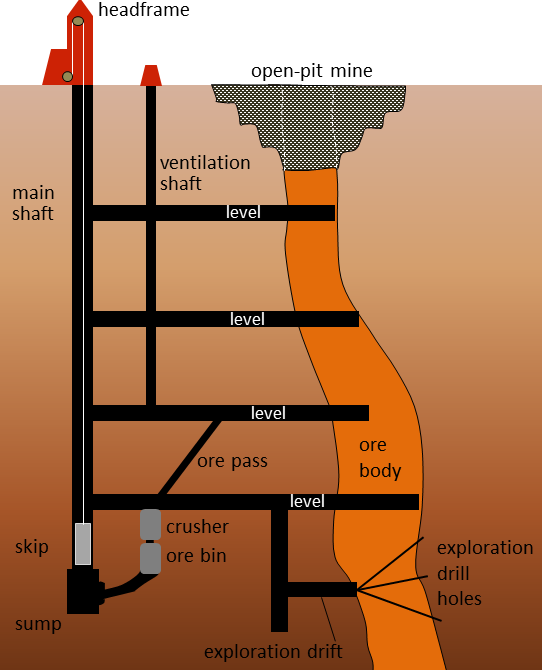
Figure \(\PageIndex{4}\): Schematic cross-section of a typical underground mine. © Steven Earle. CC BY
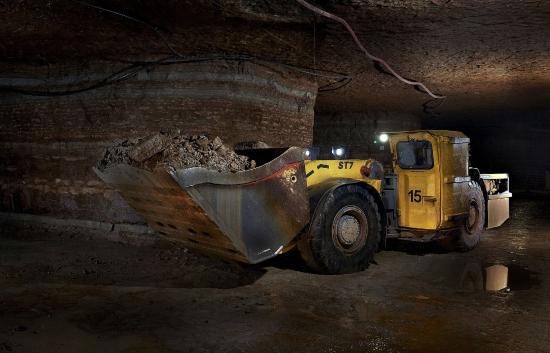
A newer form of subsurface mining known as in-situ mining is designed to co-exist with other land uses, such as agriculture. An in-situ mine typically consists of a series of injection wells and recovery wells built with acid-resistant concrete and polyvinyl chloride casing. A weak acid solution is pumped into the ore body in order to dissolve the minerals. Then, the metal-rich solution is drawn up through the recovery wells for processing at a surface refining facility where the mineral of interest is precipitated. This method is used for the in-situ mining of copper ore.
Ore Processing
Once an ore has been mined, it must be processed to extract pure metal. All ore minerals are mixed with less desirable components called gangue. The process of physically separating gangue minerals from ore-bearing minerals is called concentrating. When ore is processed (typically very close to the mine), it is ground to a fine powder and the ore minerals are physically separated from the rest of the rock to make a concentrate. At a molybdenum mine, for example, this concentrate may be almost pure molybdenite (MoS2). The rest of the rock is known as tailings. It comes out of the concentrator as a wet slurry and must be stored near the mine, in most cases, in a tailings pond. The tailings pond at the Myra Falls Mine on Vancouver Island is shown in Figure \(\PageIndex{6}\), and the settling ponds for waste water from the concentrator are shown in Figure \(\PageIndex{7}\). The tailings are contained by an embankment. Also visible in the foreground of Figure \(\PageIndex{6}\) is a pile of waste rock, which is non-ore rock that was mined in order to access the ore. Although this waste rock contains little or no ore minerals, at many mines it contains up to a few percent pyrite.
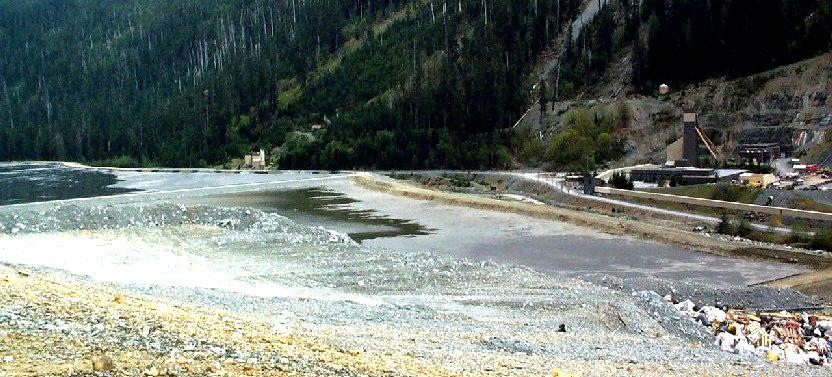
Figure \(\PageIndex{6}\): The tailings pond at the Myra Falls Mine on Vancouver Island. The dry rock in the middle of the image is waste rock. The structure on the right is the headframe for the mine shaft. Myra Creek flows between the tailings pond and the headframe. © Steven Earle. CC BY
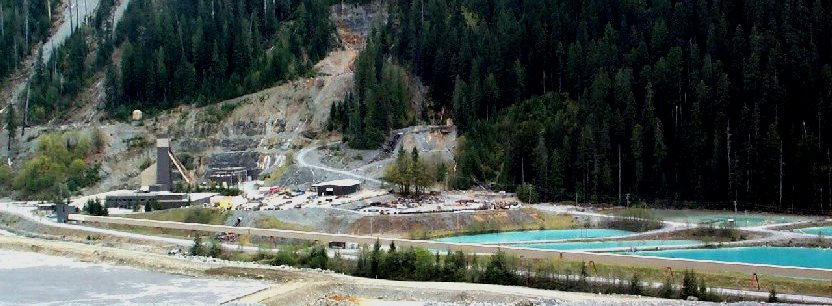
Figure \(\PageIndex{7}\): The tailings pond (lower left) at Myra Falls Mine with settling ponds (right) for processing water from the concentrator. © Steven Earle. CC BY
Processes for extracting metal include smelting, electrowinning and heap leaching. In preparation for the smelting process, the ore is crushed and concentrated by a flotation method. The concentrated ore is melted in a smelting furnace where impurities are either burned-off as gas or separated as molten slag (Figure \(\PageIndex{8}\)). Slag is the glassy unwanted by-product of smelting ore and is sometimes mistaken for metorites. The smelting step is usually repeated several times to increase the purity of the metal.
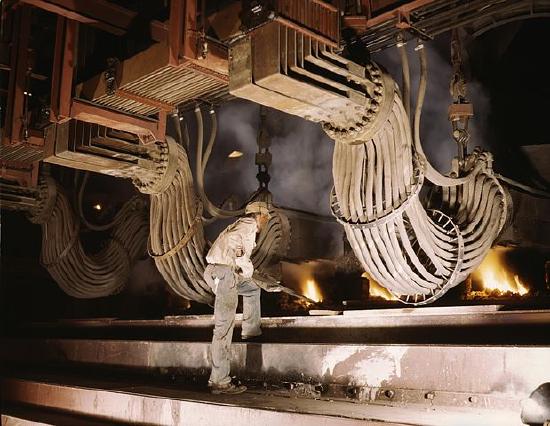
For the electrowinning method ore or mine tailings are first leached with a weak acid solution to remove the desired metal. An electric current is passed through the solution and pure metal is electroplated onto a starter cathode made of the same metal. Copper can be refined from oxide ore by this method. In addition, copper metal initially produced by the smelting method can be purified further by using a similar electrolytic procedure.
Gold is sometimes extracted from ore by the heap leaching process. A large pile of crushed ore is sprayed with a cyanide solution. As the solution percolates through the ore it dissolves the gold. The solution is then collected and the gold extracted from it. All of the refining methods can damage the environment. Smelters produce large amounts of air pollution in the form of sulfur dioxide which leads to acid rain. Leaching methods can pollute streams with toxic chemicals that kill wildlife.
Environmental Impacts of Metallic Mineral Mining
The primary impact of metallic mineral mining comes from the mining itself, including disturbance of the land surface, covering of landscapes by tailings impoundments, and increased mass wasting by accelerated erosion [48]. Surface mines can create enormous pits (Figure \(\PageIndex{2}\)) in the ground as well as large piles of overburden and tailings that need to be reclaimed, i.e., restored to a useful landscape. Since 1977 surface mines in U.S. are required to be reclaimed, and commonly reclamation is relatively well done in this country. Unfortunately, surface mine reclamation is not done everywhere, especially in underdeveloped countries, due to lack of regulations or lax enforcement of regulations. Unreclaimed surface mines and active surface mines can be major sources of water and sediment pollution.
In addition, many metal deposits contain pyrite, an uneconomic sulfide mineral placed on waste dumps, which may generate acid rock drainage (ARD) during weathering (Figure \(\PageIndex{9}\)). In the presence of oxygenated water, sulfides such as pyrite react undergo complex reactions to release metal ions and hydrogen ions, lowering pH to highly acidic levels. Mining and processing of mined materials typically increase the surface area to volume ratio in the material, causing reactions to occur even faster than what would occur naturally. If not managed properly, these reactions may lead to acidification of streams and groundwater plumes that can carry dissolved toxic metals. In mines where limestone is a waste rock of carbonate minerals like calcite or dolomite are present, their acid-neutralizing potential helps reduce the likelihood of generating ARD. Although this is a natural process too, it is very important to isolate mine dumps and tailings from oxygenated water, both to prevent the dissolution of sulfides and subsequent percolation of the sulfate-rich water into waterways. Industry has taken great strides in preventing contamination in recent decades, but earlier mining projects are still causing problems with local ecosystems.
![By Carol Stoker, NASA [Public domain], <a data-cke-saved-href="https://commons.wikimedia.org/wiki/File%3ARio_tinto_river_CarolStoker_NASA_Ames_Research_Center.jpg" href="https://commons.wikimedia.org/wiki/File%3ARio_tinto_river_CarolStoker_NASA_Ames_Research_Center.jpg">via Wikimedia Commons</a> The water in the river is bright orange.](https://bio.libretexts.org/@api/deki/files/57542/Rio_tinto_river_CarolStoker_NASA_Ames_Research_Center-300x225.jpg?revision=1&size=bestfit&width=365&height=274)
Tailings ponds and waste-rock storage piles must be carefully maintained to ensure their integrity and monitored to ensure that acidic and metal-rich water is not leaking out. In August 2014, the tailings pond at the Mt. Polley Mine in central B.C. failed and 10 million cubic metres of waste water along with 4.5 million cubic metres of tailings slurry was released into Polley Lake, Hazeltine Creek, and Quesnel Lake (Figure \(\PageIndex{10-11}\)). As of July 2015, the environmental implications of this event are still not fully understood.
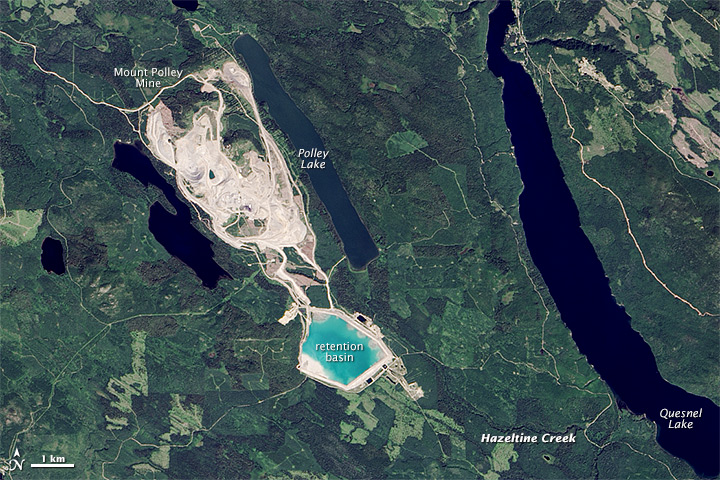
Figure \(\PageIndex{10}\): The Mt. Polley Mine area prior to the dam breach of August 2014. The tailings were stored in the area labelled “retention basin.” [https://en.Wikipedia.org/wiki/Mount_...mine_disaster]
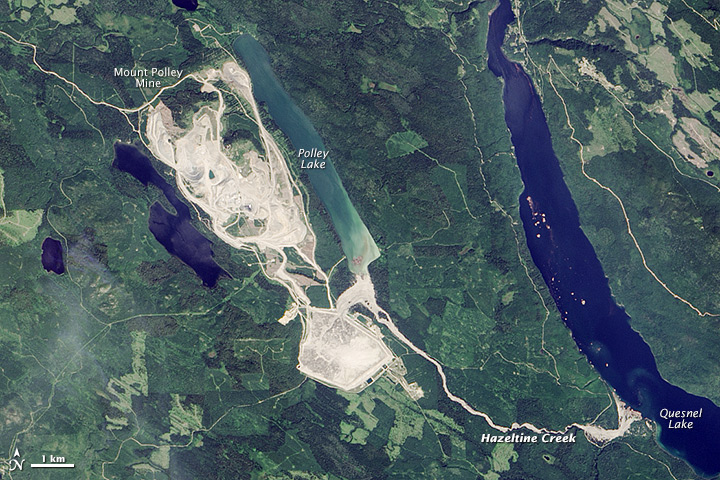
Figure \(\PageIndex{11}\): The Mt. Polley Mine area after the tailings dam breach of August 2014. The water and tailings released flowed into Hazeltine Creek, and Polley and Quesnel Lakes. [https://en.Wikipedia.org/wiki/Mount_...mine_disaster]
MINERAL SUFFICIENCY AND THE FUTURE
Mineral resources are essential to life as we know it. A nation cannot be prosperous without a reliable source of minerals, and no country has all the mineral resources it requires. The United States has about 5 percent of the world's population and 7 percent of the world's land area, but uses about 30 percent of the world's mineral resources. It imports a large percentage of its minerals; in some cases sufficient quantities are unavailable in the U.S., and in others they are cheaper to buy from other countries. Certain minerals, particularly those that are primarily imported and considered of vital importance, are stockpiled by the United States in order to protect against embargoes or other political crises. These strategic minerals include: bauxite, chromium, cobalt, manganese and platinum.
Because minerals are produced slowly over geologic time scales, they are considered non-renewable resources. The estimated mineral deposits that are economically feasible to mine are known as mineral reserves. The growing use of mineral resources throughout the world raises the question of how long these reserves will last. Most minerals are in sufficient supply to last for many years, but a few (e.g. gold, silver, lead, tungsten and zinc) are expected to fall short of demand in the near future. Currently, reserves for a particular mineral usually increase as the price for that mineral increases. This is because the higher price makes it economically feasible to mine some previously unprofitable deposits, which then shifts these deposits to the reserves. However, in the long term this will not be the case because mineral deposits are ultimately finite.
There are ways to help prolong the life of known mineral reserves. Conservation is an obvious method for stretching reserves. If you use less, you need less. Recycling helps increase the amount of time a mineral or metal remains in use, which decreases the demand for new production. It also saves considerable energy, because manufacturing products from recycled metals (e.g. aluminum, copper) uses less energy than manufacturing them from raw materials. Government legislation that encourages conservation and recycling is also helpful. The current "General Mining Act of 1872," however, does just the opposite. It allows mining companies to purchase government land very inexpensively and not pay any royalties for minerals extracted from that land. As a result, mineral prices are kept artificially low which discourages conservation and recycling.
References
4. Vogel, J. C. Groningen radiocarbon dates IX. Radiocarbon 12, 444–471 (1970).
Clugston, C. (2010) Increasing Global Nonrenewable Natural Resource Scarcity - An Analysis, The Oil Drum. Retrieved from http://www.theoildrum.com/node/6345
Craig J, Vaughan D, and Skinner B (2011) Earth Resources and the Environment (4th ed.). Pearson Prentice Hall, p. 92
Contributors and Attributions
Modified by Kyle Whittinghill from the following sources
- Metal Deposits from Physical Geology by Steven Earle (licensed under a Creative Commons Attribution 4.0 International License)
- Minerals from AP Environmental Science by University of California College Prep
- Non-Renewable Resources from Environmental Science: A Canadian Perspective by Bill Freedman (Creative Commons Attribution NonCommercial)
- Mineral Resources and Mining from An Introduction to Geology by Chris Johnson, Matthew D. Affolter, Paul Inkenbrandt, & Cam Mosher (Geology Faculty at Salt Lake Community College), download free from OpenGeology
- Mineral Resources: Formation, Mining, Environmental Impact from Sustainability: A Comprehensive Foundation by Tom Theis and Jonathan Tomkin


